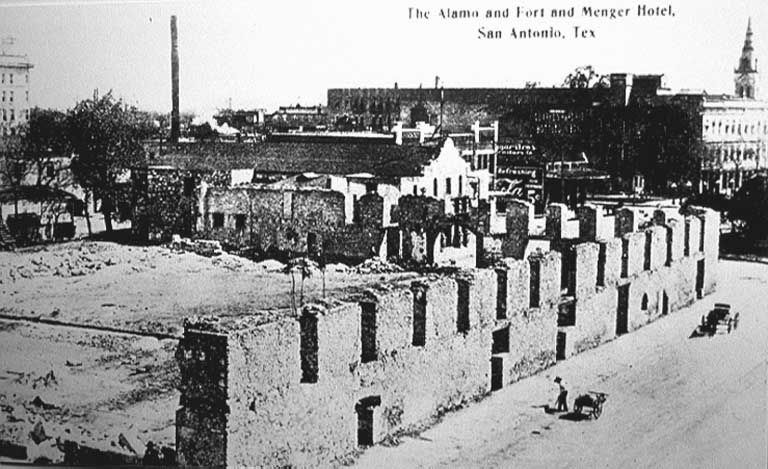![]()

Too Much Rain Cracks
West Wall Of Alamo Fort.
San Antonio Express newspaper, Oct. 9, 1913, Thursday.
State officials and the legal representative of the Daughters of the Republic agreed that the upper part of the west wall of the Alamo fort was a menace, so workmen yesterday tore away much of the ancient masonry. In the last few days the west wall began showing signs of disintegration as a result of the recent heavy rains. Cracks from five to ten feet in length appeared a few days ago. The hot sunshine of the last day or two widened the fissures to so great an extent that Dr. A. R. Conley, State Superintendent of Public Buildings and Grounds, and J. B. Nitschke, State Superintendent of Masonry, were asked to make an examination of the historical structure. Both officials went over the property yesterday morning, and it was then decided a large part of the wall should come down. Mr. Nitschke took up the matter with J. E. Webb, attorney for the Daughters of he Republic. The latter said if the wall was at all a menace to pedestrians as much of it as was in a dangerous condition should be torn away. Mr. Nitschke also communicated the result of his findings to the Governor's office and told what would be done in the matter. So he got together a half dozen laborers and with the aid of an improvised battering ram razed all of that section of the wall which seemed likely to topple over on the sidewalk. It required only an hour or two to finish the job. "In this particular connection I want to correct an impression which seems to have gone forth," Mr. Nitschke said. "The portion of the wall razed this afternoon is of the old construction. It is of the adobe construction and there being no roof to shelter it, the heavy rainfall of the recent days seeped deeper and deeper into the mud holding the rock, and then the cracks began to show up. Just as soon as the sun appeared these cracks naturally widened, and then there was only one thing to do, and that was to remove the dangerous part. "This wall should not be confused with the recent construction on the Alamo, the greatest part of which been behind the outside walls. It is to be hoped the remainder of the old wall can be preserved and again restored to its original condition. It was with much regret that I saw a portion of the old wall come down today, but everything considered, I believe preventative measures are always best in the end." Mr. Nitschke will remain in town to day. Despite all of the agitation concerning the restoration of the Alamo, he believes the next Legislature will make provision to carry on the work. Dr. Conley returned to Austin yesterday afternoon, after assuring himself that it would be best to remove the dangerous part of the wall.
![]()